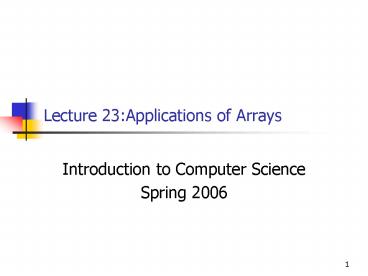Lecture 23:Applications of Arrays - PowerPoint PPT Presentation
Title:
Lecture 23:Applications of Arrays
Description:
List has no more elements left. Average number of comparisons made by the ... Uses the 'divide and conquer' technique. Compare search item to middle element ... – PowerPoint PPT presentation
Number of Views:14
Avg rating:3.0/5.0
Title: Lecture 23:Applications of Arrays
1
Lecture 23Applications of Arrays
- Introduction to Computer Science
- Spring 2006
2
Sequential Search
- Sequential search search a list for an item
- Compare search item with other elements until
either - Item is found
- List has no more elements left
- Average number of comparisons made by the
sequential search equals half the list size - Good only for very short lists
3
int seqSearch(const int list, int listLength,
int searchItem) int loc for (loc 0 loc
lt listLength loc) if (listloc
searchItem) return loc return -1
4
Sorting a List Bubble Sort
- Suppose list0...listn - 1 is a list of n
elements, indexed 0 to n 1 - Bubble sort algorithm
- In a series of n - 1 iterations, compare
successive elements, listindex and listindex
1 - If listindex is greater than listindex 1,
then swap them
5
(No Transcript)
6
(No Transcript)
7
Bubble Sort Algorithm
for i 0 to n-1 do for j 0 to n - i -
1 do if listj gt listj1 then
Swap(listj , listj1)
void bubbleSort(int list, int length) int
temp int i, j for (i 0 i lt length -
1 i) for (j 0 j lt length -
1 - i j) if (listj gt listj
1) temp
listj listj listj 1
listj 1 temp
8
Sorting a List Selection Sort
- Selection sort rearrange list by selecting an
element and moving it to its proper position - Find the smallest (or largest) element and move
it to the beginning (end) of the list
- On successive passes, locate the smallest item in
the list starting from the next element
9
Selection Sort Algorithm
- for (index 0 index lt length - 1 index)
- Find the location, smallestIndex, of the smallest
element in listindexlistlength-1. - Swap the smallest element with listindex. That
is, swap listsmallestIndex with listindex
void selectionSort(int list, int length)
int index int smallestIndex int
minIndex int temp for (index 0 index lt
length - 1 index) //Step
a smallestIndex index for (minIndex
index 1 minIndex lt length minIndex) if
(listminIndex lt listsmallestIndex) smalles
tIndex minIndex //Step b temp
listsmallestIndex listsmallestIndex
listindex listindex temp
10
Sequential Search on an Ordered List
- General form of sequential search algorithm on a
sorted list
11
Sequential Search on an Ordered List
int seqOrderedSearch(const int list, int
listLength, int searchItem) int
loc //Line 1 bool found false //Line
2 for (loc 0 loc lt listLength
loc) //Line 3 if (listloc gt
searchItem) //Line 4 found
true //Line 5 break //Line 6
if (found) //Line 7 if
(listloc searchItem) //Line 8 return
loc //Line 9 else //Line 10
return -1 //Line 11 else //Line 12
return -1 //Line 13
12
Binary Search
- Binary search can be applied to sorted lists
- Uses the divide and conquer technique
- Compare search item to middle element
- mid (firstlast)/2
- first is the starting index of the search list
- last is the ending index of the search list
- mid is the index of the middle element of the
search list - If search item is less than middle element,
restrict the search to the lower half of the list - Otherwise search the upper half of the list
13
Search 75 in the following list
14
Binary Search
int binarySearch(const int list, int
listLength, int searchItem) int first
0 int last listLength - 1 int mid bool
found false while(first lt last
!found) mid (first last) /
2 if(listmid searchItem) found
true else if(listmid gt searchItem)
last mid - 1 else first mid
1 if(found) return mid else
return -1
15
Binary Search (continued)
- Every iteration cuts size of search list in half
- If list L has 1000 items
- At most 11 iterations needed to determine if an
item x is in list - Every iteration makes 2 key (item) comparisons
- Binary search makes at most 22 key comparisons to
determine if x is in L - Sequential search makes 500 key comparisons
(average) to if x is in L for the same size list
16
End of lecture 23
- Thank you!































